If you’ve noticed that your brake rotors have developed heavy rust buildup, you may wonder what steps to take to address the issue. Rust on brake rotors can not only be unsightly, but it can also affect the performance of your brakes.
This article will discuss the options for dealing with heavy rust on brake rotors. We will cover the pros and cons of different methods, including removing the rust yourself or replacing the rotors entirely.
By the end of this article, you will have a better understanding of how to address heavy rust on your brake rotors effectively. Let’s get started!
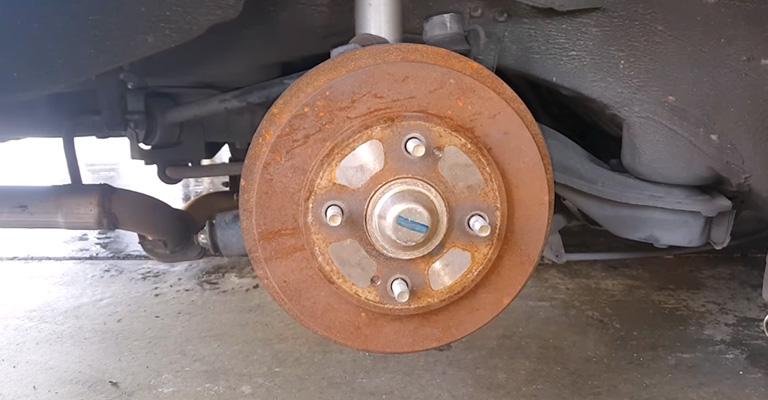
Contents
- 0.1 Where’s The Rust?
- 0.2 Are Rusty Brake Discs a Problem?
- 0.3 Rust on Brake Discs
- 0.4 What Happens If You Don’t Remove Brake Rotor Rust?
- 0.5 Can You Prevent It?
- 0.6 Why Do Car Brake Rotors Rust So Quickly?
- 0.7 When Is Too Much Rust, Too Much?
- 0.8 Rust on Calipers
- 0.9 How Do I Fix A Rusted Rotor?
- 1 Final Words
Where’s The Rust?
It is unlikely that a vehicle’s brake rotors will rust if it is driven regularly. Rusty rear rotors on a vehicle being regularly driven generally indicate a problem with a caliper or proportioning valve if one or more rear rotors are rusted.
In parked vehicles, rotor braking surfaces will rust, and with rust comes brake noise. A rusty rotor surface will make the brake noise last for a few weeks.
If you drive a vehicle through a puddle right before parking for a few weeks (think airport), some water can get trapped between the pads and the rotor, causing rust to form and causing a strange sensation while stopping that is a bit like a braking pulse.
If the roads are salted in the winter in northern states, the brake components will rust by default.
Are Rusty Brake Discs a Problem?
You discover rust on some brake components while performing your regular brake maintenance. Is there anything you should do?
There is no reason to worry about corrosion occurring in some parts of the vehicle’s braking system. Replacements may be necessary if you notice extensive rust on the brake discs and calipers.
Rust on Brake Discs
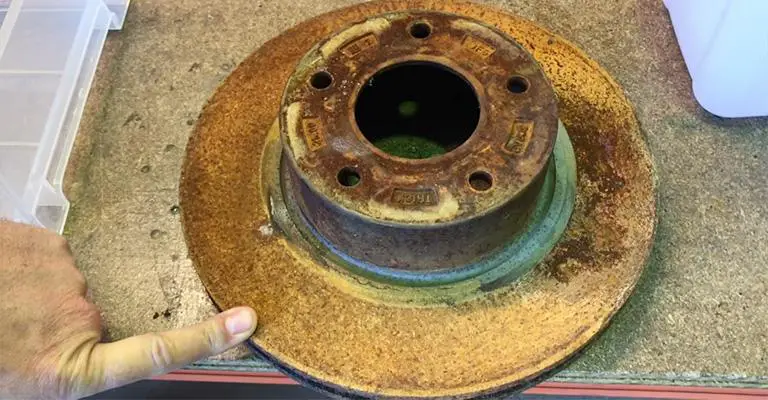
In many situations, brake discs (or rotors) rust. When you leave your vehicle parked outside during heavy snow or rain, these discs may develop a thin film of rust.
The presence of rust on the surface of your brake discs is not a problem. If you drive your vehicle and use your brakes, surface-level rust will usually disappear on its own.
In contrast, it is a different story if your brake discs are severely corroded. You may experience a reduction in your vehicle’s braking performance. You may notice that you wear your brake pads more quickly if you have accumulated rust on your discs.
To avoid such issues, ensure that severely rusted brake discs are replaced immediately.
In addition to reducing the efficiency of your disc brake system, worn discs and pads can also contribute to it. Eventually, your brake discs and pads will become severely rusted, and grinding noises will begin to occur.
Usually, that type of noise comes from pads that have lost all their lining, leaving the metal pad backing to grind against the rotor.
What Happens If You Don’t Remove Brake Rotor Rust?
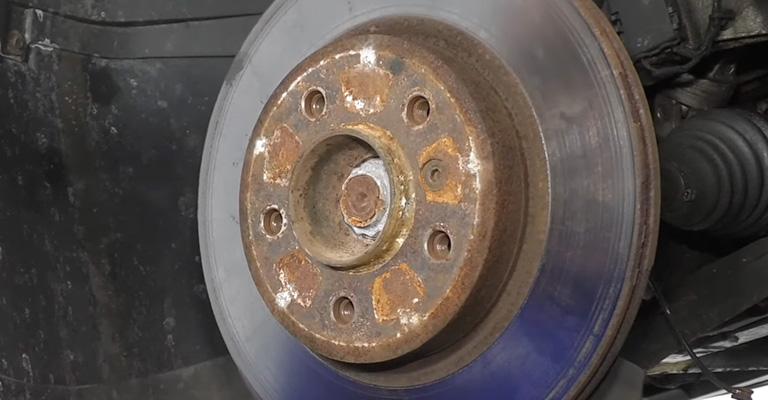
The good news is that it’s relatively easy to remove brake rotor rust, especially if the amount is minimal. Even though a bit of surface rust doesn’t look pretty, it doesn’t cause any significant problems other than a brief brake squeal when you apply the brakes.
Despite this, rust can spread if left unchecked. As a result, brake pads could rust, and calipers could seize up. Furthermore, corrosion is a chemical reaction converting iron into iron oxide.
Your rotor’s face is literally eaten away, leaving pockmarks, depressions, and scars that decrease braking effectiveness. In some cases, you can resurface the rotors, but if the rotors are too thin, you will not be able to do so.
It’s good to know that rusty rotors are indicative of other problems, including rusted-out brake lines. Rust can cause damage to your boat, but a few simple steps can stop it.
Can You Prevent It?
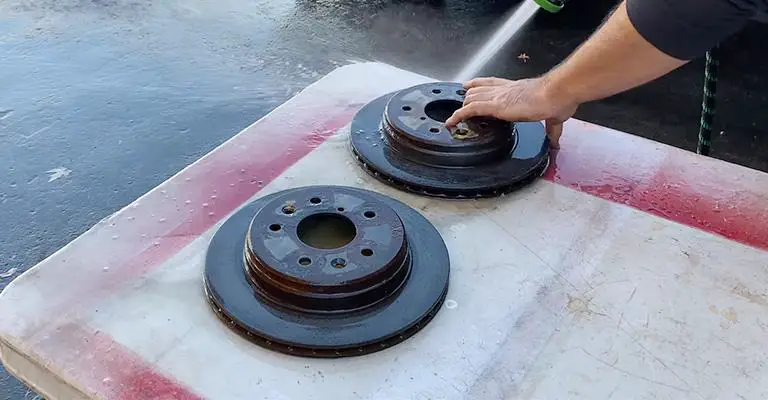
Now that OEMs know this, cast-iron brake rotors and steel brake rotors rust quickly. For this reason, many rotors come with anticorrosion coatings at the factory.
Despite this, the friction between brake pads and rotor faces quickly wears away those coatings into dust. Once that occurs, iron and water can mix freely.
Nevertheless, some solutions may be found there. A rusty surface is impossible without iron alloys. By installing carbon-ceramic brake pads and rotors, rust becomes a thing of the past.
Alternatively, you could shield the iron or steel surface with a non-corroding barrier. Those are the Surface Coated Brakes Porsche makes using iron rotors and tungsten carbide coatings.
Furthermore, it makes the rotors quieter, last longer, and produce less dust due to preventing rust.
You can place the brake rotors in an arid climate as a second option. Rust doesn’t form where there is no moisture. Nevertheless, big temperature changes can still lead to condensation.
In low-moisture climates, rust can also happen due to brake friction heating up. Even though it won’t come on as quickly, it’s not as foolproof as taking the iron out.
As a result, some people have advertised painting brake rotors and calipers to prevent rust. However, you could only get away with it if you painted it with high-temperature paint.
Nevertheless, you cannot paint the rotor face or the surfaces where the brake pads come into contact with the rotor. This will result in an improper grip between the pad and rotor and ineffective heat dispersion. When you’ve got uncoated iron rotors, some face rust happens because of the paint that shields it from rust.
Why Do Car Brake Rotors Rust So Quickly?
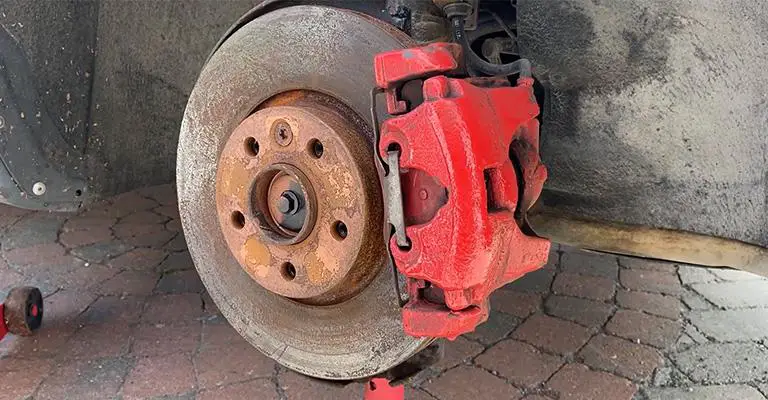
Rust is a common problem when you drive on salty winter roads and doesn’t just affect brake rotors. However, corrosion will creep across your rotors regardless of whether they’re covered in salty slush or rain.
If you park your car for a few days or wash it thoroughly, you’ll likely notice rust soon. There is no denying that brake rotor rust is an inevitable part of car ownership.
Because most disc brake rotors are made of cast iron or carbon steel, this inevitable outcome is unavoidable. Due to this, they are durable and inexpensive, but they are also heavy. It is also important to keep in mind that iron plus ambient moisture equals rust.
Additionally, most brake pads are metallic or semi-metallic, and their backing plates are often made of steel or iron. As a consequence, they also rust. Moreover, if the dust they often produce isn’t removed, a connection exists between the pad and the rotor.
In this way, the rust spreads. This can be observed when cars are parked for long periods and when electric cars rely too heavily on regenerative braking. There isn’t any exercise for the physical brakes, so they rust rotors and all.
When Is Too Much Rust, Too Much?
It is usually enough to start your car, come to a stop once and let it idle to wipe off surface rust on your rotors after leaving your car parked outside overnight in the rain.
When your vehicle has driven a few kilometers, you might notice that the rust on the top portion of the rotors is much thicker and darker than the rust on the surface that contacts the pad. It is still normal to have rust on discs, which won’t affect the disc’s performance.
Rust on Calipers
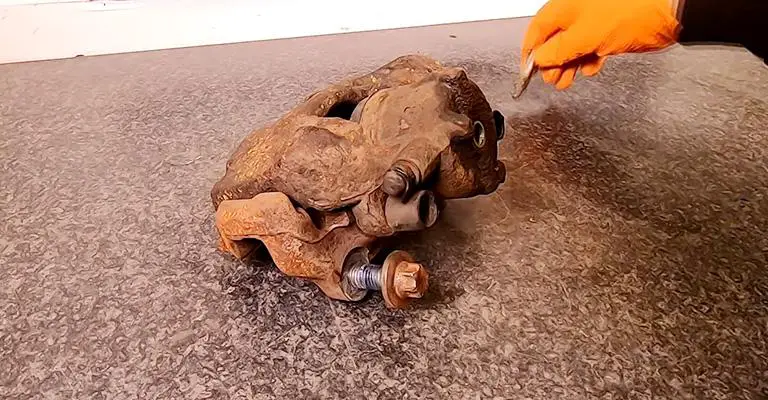
Besides severely rusted brake discs and brake calipers, brake calipers are also vulnerable to rust. Is it a problem if my brake calipers are rusty?
Calipers can be heavily rusted, so don’t ignore them. The main reason for not looking at calipers is that nobody looks at them unless they have to repair their brakes.
It’s even worse if steel caliper frames aren’t painted, even if they’re in perfect condition. In other words, if the rust affects the caliper’s function or is located in the wrong places, that can be a problem.
Surface rust is harmless, but excessive rust can prevent a floating caliper from being centered over the rotors when its slides, bushings, and pins are rusted.
Consequently, your brake pads may wear out unevenly and not be as reliable as they should be. If you keep your brakes in good condition, you should watch for rusty brake calipers.
Floating calipers that are severely rusted can stick, which can then cause your brake pads to drag. The reason is that the brake caliper may not release fully because it is not allowing enough movement.
The surfaces of many caliper pistons are plated with nickel or chrome to achieve the desired appearance.
When compared with phenolic caliper pistons (which are naturally thermal insulators), steel pistons may be able to transfer heat between the brake pads and the brake fluid.
It is important that the surface finish on these pistons is as smooth as possible to ensure effectiveness.
How Do I Fix A Rusted Rotor?
Neither fix is always needed, but you might have to take your car to a machine shop if your rotor is damaged beyond repair.
In this process, they will grind away the rusted surface of the disc, exposing a nice clean and bare area to grip and for the brake pads to apply good pressure.
In cases where the damage is too severe, or the machine shop considers the rotor irreparable, you will have to get a new set of rotors.
Final Words
Applied brakes are vital in wiping off accumulated oxidation on the surface of your rotor because oxidation eats away at the metal due to oxidation and rust. When surface rust penetrates deeper, it can compromise the disc’s structural integrity.
